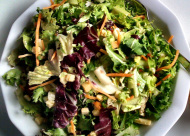Sesame yogurt pasta salad
- 17 ingredients
- Servings per recipe: 1
- Serving size: 1.1 kg
Preparation & details:
www.101cookbooks.com/archives/sesame-yogurt-pasta-salad-recipe.html
Source: 101 Cookbooks
121 recipes on HappyForks
Amount per 100 g
- Energy (calories): 128 kcal 6%
- Protein: 4.43 g 8%
- Fat: 9.15 g Why gray? Help 19%
- Carbohydrates: 9 g 4%
Calorie breakdown
Help
- Protein: 12% 15 kcal
- Fat: 61% 78 kcal
- Carbohydrates: 27% 35 kcal
Omega 6 : Omega 3
Help
1:1 20:1 35:1
General
Energy
128 kcal
6%
Water
76.09 g
3%
Carbohydrates
Carbohydrate
9 g
4%
Fiber
2.3 g
9%
Sugars, total
2.26 g
Starch
2.17 g
Lipids
Total lipid (fat)
9.15 g
19%
Total polyunsaturated
2.99 g
Omega 3 (n-3)
0.082 g
6%
Omega 6 (n-6)
2.897 g
24%
Total monounsaturated
4.233 g
Total saturated
1.461 g
as low as possible
Total trans
0.017 g
as low as possible
Cholesterol
3 mg
as low as possible
Protein + aminoacids
Protein
4.43 g
8%
Tryptophan
0.061 g
19%
Threonine
0.137 g
11%
Isoleucine
0.143 g
12%
Leucine
0.254 g
9%
Lysine
0.155 g
6%
Methionine + Cystine
0.15 g
12%
Methionine
0.087 g
Cystine
0.063 g
Phenylalanine + Tyrosine
0.289 g
14%
Phenylalanine
0.169 g
Tyrosine
0.12 g
Valine
0.188 g
12%
Vitamins
Vitamin C
17.7 mg
24%
Folate, total
39 µg
Folate, DFE
43 µg DFE
11%
Vitamin B-1 (Thiamin)
0.187 mg
17%
Vitamin B-2 (Riboflavin)
0.129 mg
12%
Vitamin B-3 (Niacin)
1.158 mg
8%
Vitamin B-5 (Pantothenic acid)
0.259 mg
5%
Vitamin B-6
0.109 mg
8%
Vitamin B-12 (Cobalamin)
0.09 µg
4%
Vitamin A
414 IU
18%
Vitamin E
0.81 mg
5%
Vitamin D
1 IU
0%
Vitamin K
21.9 µg
24%
Isoflavones, total
0 mg
Minerals
Calcium, Ca
88 mg
9%
Magnesium, Mg
25 mg
8%
Phosphorus, P
127 mg
18%
Iron, Fe
1.61 mg
9%
Potassium, K
227 mg
5%
Sodium, Na
134 mg
9%
Zinc, Zn
0.77 mg
10%
Copper, Cu
0.227 mg
25%
Selenium, Se
7.5 µg
14%
Manganese, Mn
0.311 mg
17%
Similar recipes
Ingredients
| Ingredient description | Matched product |
|---|---|
| Sauce | |
| 2 tablespoons extra virgin olive oil | Oil · olive · salad or cooking - 2 tbsp |
| 1 medium garlic clove, minced | Garlic · raw - 1 clove |
| 1/2 teaspoon ground cumin | Spices · cumin seed - 0.5 tsp, whole |
| 1/2 teaspoon ground coriander | Spices · coriander seed - 0.5 tsp |
| 1/4 teaspoon cayenne pepper | Spices · pepper · red or cayenne - 0.25 tsp |
| 1/2 teaspoon turmeric | Spices · turmeric · ground - 0.5 tsp |
| 1/2 cup / 120 ml warm water | Water · bottled · generic - 0.5 cup |
| 1/2 cup / 120 ml tahini (sesame paste) | Seeds · sesame butter · tahini · from roasted and toasted kernels (most common type) - 0.5 cup |
| 1/2 cup / 120 ml plain or Greek yogurt | Yogurt · Greek · plain · nonfat - 0.5 container |
| 3 tablespoons fresh lemon juice | Lemon juice · raw - 3 tbsp |
| fine grain sea salt | Salt · table - 0.25 tsp |
| Salad | |
| a big handful of broccoli florets | Broccoli · raw - 1 cup chopped |
| a big handful of cauliflower florets | Cauliflower · raw - 1 cup chopped (1/2" pieces) |
| a big handful of green beans, cut into 1 1/2-inch segments | Beans · snap · green · raw - 1 cup 1/2" pieces |
| 1/2 pound / 8 oz / 225 g stuffed pasta (ravioli, etc) | Ravioli · cheese · with tomato sauce · frozen · not prepared · includes regular and light entrees - 225 g |
| a big handful/scoop of cherry tomatoes, raw or roasted | Tomatoes · red · ripe · raw · year round average - 1 cup cherry tomatoes |
| a small handful torn basil and/or cilantro | Basil · fresh - 0.5 cup leaves, whole |
Possible differences in nutritional values
All the nutritional values are calculated based on the above products from HappyForks. The precise nutritional values of your recipe may differ due to the use of some specific foods, which not always have a perfect fit in HappyForks. The ingredients used in the recipe may have also different nutritional values than those in our database.
About Nutrition Facts
- Symbol "~" means missing value.
- Percentages next to nutrients show the proportion of daily recommended intake level of nutrients for a healthy person, whose data are included in the nearby profile.
- Nutrition recommendations based on Dietary Reference Intake (DRI) developed by the Institute of Medicine, source.
Advanced mode
- RDA (Recommended Dietary Allowances) - the daily daietary intake level of a nutrient that meet the requirements of 97.5% of healthy individuals in particular age group and gender.
- AI (Adequate Intake) - recommended average daily nutrient intake assumed to be adequate based on approximation of observed mean nutrient intake by a group of healthy people, used when an RDA cannot be determined.
- UL (Tolerable upper intake levels) - the highest level of daily consumption that current data have shown to cause no side effects in humans when used indefinitely without medical supervision.





